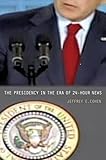The Presidency in the Era of 24-Hour News / Jeffrey E. Cohen.
Material type: TextPublisher: Princeton, NJ : Princeton University Press, [2010]Copyright date: ©2008Edition: Course BookDescription: 1 online resource (288 p.) : 31 line illus. 16 tablesContent type:
TextPublisher: Princeton, NJ : Princeton University Press, [2010]Copyright date: ©2008Edition: Course BookDescription: 1 online resource (288 p.) : 31 line illus. 16 tablesContent type: - 9780691137179
- 9781400837793
- Mass media -- Political aspects -- United States
- Mass media -- Political aspects -- United States
- Presidents -- Press coverage -- United States
- Presidents -- Press coverage -- United States
- Presidents -- United States
- Presidents -- United States
- Press and politics -- United States
- Press and politics -- United States
- POLITICAL SCIENCE / Political Process / General
- 352.230973
- JK516
- online - DeGruyter
- Issued also in print.
| Item type | Current library | Call number | URL | Status | Notes | Barcode | |
|---|---|---|---|---|---|---|---|
 eBook
eBook
|
Biblioteca "Angelicum" Pont. Univ. S.Tommaso d'Aquino Nuvola online | online - DeGruyter (Browse shelf(Opens below)) | Online access | Not for loan (Accesso limitato) | Accesso per gli utenti autorizzati / Access for authorized users | (dgr)9781400837793 |
Frontmatter -- Contents -- Illustrations -- Tables -- Preface -- Acknowledgments -- Chapter 1. The Growing Disconnect between Presidential News Coverage and Public Opinion -- Chapter 2. The Presidential News System during the Golden Age of Presidential Television -- Chapter 3. The New Media Age and the Decline in Presidential News -- Chapter 4. Change in Presidential News over the Long Haul -- Chapter 5. The Increasing Negativity in Presidential News in the Age of New Media -- Chapter 6. Sources of Negativity in Presidential News during the Age of New Media -- Chapter 7. The Declining Audience for News and the New Media Age -- Chapter 8. Declining Trust in the News Media and the New Media Age -- Chapter 9. The Implications of the New Media on the Presidential News System and Presidential Leadership -- Chapter 10. Conclusions: The New Media, the Presidency, and American Politics -- Notes -- Bibliography -- Index
restricted access online access with authorization star
http://purl.org/coar/access_right/c_16ec
The Presidency in the Era of 24-Hour News examines how changes in the news media since the golden age of television--when three major networks held a near monopoly on the news people saw in the United States--have altered the way presidents communicate with the public and garner popular support. How did Bill Clinton manage to maintain high approval ratings during the Monica Lewinsky scandal? Why has the Iraq war mired George Bush in the lowest approval ratings of his presidency? Jeffrey Cohen reveals how the decline of government regulation and the growth of Internet and cable news outlets have made news organizations more competitive, resulting in decreased coverage of the president in the traditional news media and an increasingly negative tone in the coverage that does occur. He traces the dwindling of public trust in the news and shows how people pay less attention to it than they once did. Cohen argues that the news media's influence over public opinion has decreased considerably as a result, and so has the president's ability to influence the public through the news media. This has prompted a sea change in presidential leadership style. Engaging the public less to mobilize broad support, presidents increasingly cultivate special-interest groups that often already back the White House's agenda. This book carries far-reaching implications for the future of presidential governance and American democracy in the era of new media.
Issued also in print.
Mode of access: Internet via World Wide Web.
In English.
Description based on online resource; title from PDF title page (publisher's Web site, viewed 30. Aug 2021)


